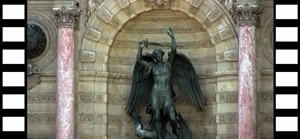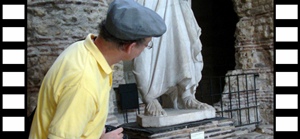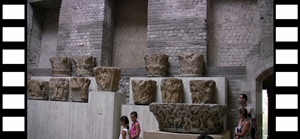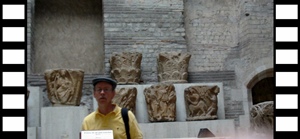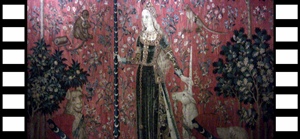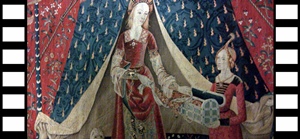Getting to the Cluny Museum from Sainte-Chapelle involved crossing the Seine
via the Pont St-Michel and passing through the Place St-Michel. From here it
was a short walk down the Boulevard St-Michel to the museum, at the corner of
the Boulevard St-Germain.

Public Toilet, Ile de la Cité

Seine and Left Bank

Seine and Place St-Michel

The Cluny Museum
The Cluny Museum, or Musée de Cluny (official name Musée National du Moyen Âge,
or National Museum of the Middle Ages), houses Renaissance and pre-Renaissance artifacts
from throughout Europe, with an emphasis on things French. The Cluny name comes from its
former life as the town house of the abbots of Cluny. It was first built in the 14th
Century atop and among the ruins of a Gallo-Roman bath complex from the 3rd Century A.D.
The baths were apparently built by the Romans in an attempt to "Romanize" the Gauls.
This didn't work out that well – the fact that the baths were built outside the city's
fortifications left them vulnerable to attack, and they were pretty much trashed by the
end of the century in which they were built. But some of the walls have survived and
have been incorporated into the structure of the museum, and one structure, the
frigidarium, is pretty much intact.

Nella in the Frigidarium

In the Frigidarium
After the time of the abbots, the main building was rebuilt in Renaissance style and
spent the centuries as a residence for an assortment of people (including the sister
of Henry VIII of England, the astronomer Charles Messier, who used it as an
observatory, and a physician who used its chapel as a dissecting room). It became a
museum in 1843, starting with a collection of artifacts left by archeologist and art
collector Alexandre du Sommerard, who had died a year earlier.
Museum Forecourt

Nella with Sundial

Bob in Forecourt
Since that time, additional artifacts, including new discoveries, have been acquired
and put on display. This includes the heads of 21 of the 28 king statues (discovered
in 1977) that were removed from the Notre-Dame cathedral and decapitated during the
French Revolution.
Kings of Judah (Modern Copies)

Heads of Kings of Judah (13th C.)

Decapitated Kings
Entry to the Cluny Museum was included in our Museum Passes. We entered the museum
by passing through a bookstore and using a doorway to the left. The collection of
artifacts we saw was well-preserved and amazing (you can see more at
their website).

Statues and Altarpiece

Altarpiece of the Passion (16th C.)

Tapestry - The Deliverance of St. Peter (ca. 1460)

Carved Figure

Alabaster Panels (England, 15th C.)

Sainte-Chapelle Glass Panel (13th C.)

Saints in Glass (Rouen, ca. 1300)

Nella Descending Staircase

Notre-Dame Portal Fragments (ca. 1145)

Ivory Diptych Leaf (Constantinople, 506 A.D.)

Ivory Ariadne (Constantinople, 6th C.)

Saint-Sulpice Triptych (13th C.)

Nella with Casket, Crucifix and Capitals

Bob with Capitals and Crucifix

St-Germain-des-Prés Capitals (11th C.)

Casket Covered in Saints
Columns in Frigidarium
However, we were not able to find a collection of tapestries featuring a lady and a
unicorn, billed as the museum's number one attraction. We passed through all the
rooms we could find and ended up back in the bookstore. But then we went into a
room to the right, which we’d thought was a storeroom, as we'd seen stacked-up
boxes in it, and it turned out to have a stairway to the upper floor of the museum.
Here we found more artifacts.
Sword and Helmet (Germany, 16th C.)

Tapestry - The Grape Harvest (Netherlands, 16th C.)

Reliquary (15th C.)

Man Praying, Guys with Sticks

The Mass of St. Gregory (15th C.)

Crozier Heads, Reliquaries, Hand Warmers

Reliquary (Portugal, 16th C.)

Carving of Circumcision

Altarpiece Detail
Eventually we also found the tapestries (we had to go down an unpromising-looking
hallway at one point – be sure to get a map if you visit this museum). The tapestries
date from the 15th Century, when they were designed in Paris and woven in Flanders.
They resided for a time in the Château de Boussac, located well to the south of Paris.
They were acquired from the Château by the Cluny in 1882 and are displayed in a
controlled setting due to their fragile condition. They have made appearances in
popular culture, being the subject of a Tracy Chevalier novel and appearing in the
background of the Gryffindor Common Room in the Harry Potter movies. The tapestries
feature the lady and the unicorn and other participants in settings intended to
represent each of the five senses. Here they are:

Sense of Taste

Sense of Hearing

Sense of Smell

Sense of Touch

Sense of Touch

To My Only Desire
To My Only Desire
After leaving the museum we found some lunch and went back to the hotel to rest a bit.
Refreshed, we reemerged and struck out for our next destination, the Musée d'Orsay.



